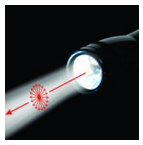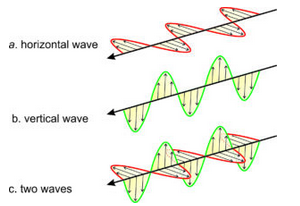5.3.1: Polarized Light
- Page ID
- 18975

The vibration direction of a light wave (which is the direction of motion of the electric wave) is perpendicular, or nearly perpendicular, to the direction the wave is propagating. In normal unpolarized beams of light, waves vibrate in many different directions, shown by arrows in Figure 5.15.

We can filter an unpolarized light beam to make all the waves vibrate in one direction parallel to a particular plane (Figure 5.16). The light is then plane polarized, sometimes called just polarized. (Unlike the drawings in Figure 5.16, a beam of white light, whether polarized or not, may contain many different wavelengths.) Figure 5.16a shows a wave vibrating horizontally and Figure 5.16b shows one vibrating vertically. Figure 5.16c shows the two polarized rays together. They are in phase but need not be.

Figure 5.17 shows what happens when a beam of unpolarized light encounter a polarizing filter. Only two vibration directions are shown for the unpolarized light but you should envision light vibrating in all directions before it reaches the filter. After passing through the filter, all light that remains in constrained to vibrate in one plane. It is plane polarized. In this figure, the polarization direction is horizontal, but it could be in any direction if we rotated the filter.

Light becomes polarized in different ways. Reflection from a shiny surface can partially or completely polarize light. Light vibrating in planes parallel to the reflecting surface is especially well reflected, while light vibrating in other directions is absorbed. This is why sunglasses with polarizing lenses help eliminate glare. Figure 5.18 contains two views of a stream containing fish. The view on the left shows lots of glare caused by light reflecting from the water surface. The light is polarized horizontally because the surface is horizontal. The view on the right is through a polarizing filter that only allows us to see light vibrating vertically. Reflections from roads and many other surface cause glare that can be eliminated with polarizing sunglasses.


